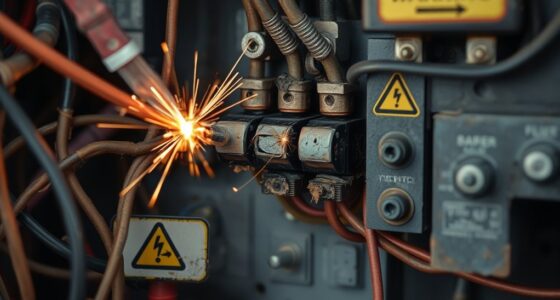Your vehicle’s CAN bus system allows the different electronic control units (ECUs) to communicate quickly and smoothly, controlling everything from the engine to your entertainment system. This network helps your car respond fast to driving conditions and diagnose issues efficiently. If there’s a malfunction, warning lights may appear on your dashboard. Understanding how the CAN bus works can help you better grasp what’s happening inside your vehicle and how to keep it running well. Keep exploring to learn more about this crucial system.
Key Takeaways
- The CAN bus allows vehicle systems like engine, brakes, and entertainment to communicate quickly and efficiently.
- ECUs act as control centers, sending and receiving data to coordinate vehicle functions.
- Warning lights, such as the check engine light, can indicate issues with the CAN bus network.
- Faulty wiring or malfunctioning ECUs can disrupt communication, affecting vehicle performance.
- Professional diagnostics are essential for identifying and fixing CAN bus system problems safely.

Have you ever wondered how modern vehicles communicate seamlessly? It’s all thanks to a system called the Controller Area Network, or CAN bus. This technology allows different electronic control units (ECUs) within your car to talk to each other efficiently. When you start your engine or turn on your headlights, various ECUs—like those managing the engine, brakes, or entertainment system—exchange information over the CAN bus. This communication happens almost instantaneously, guaranteeing your vehicle responds accurately to your commands and operates smoothly. Without this network, each component would have to function independently, making coordination impossible and increasing the risk of malfunctions.
Understanding ECU communication is key to grasping how your vehicle functions behind the scenes. Each ECU acts like a specialized brain, controlling a specific aspect of your car. They send and receive messages via the CAN bus, which is a resilient, multi-wire data network. When you press the accelerator, for example, the engine ECU receives signals from various sensors, processes the data, and communicates with the transmission ECU to adjust gear shifts accordingly. This constant exchange of information guarantees maximum performance and efficiency. If one ECU encounters a fault or stops communicating properly, your vehicle might display warning lights or behave unpredictably. That’s where network troubleshooting comes into play. Technicians use specialized tools to diagnose issues within the CAN bus system, checking for broken wires, faulty ECUs, or communication errors. They analyze error codes and monitor data flow to pinpoint problems quickly, preventing small issues from turning into costly repairs or dangerous driving conditions.
For you, as a driver, understanding the basics of CAN bus and ECU communication can demystify some of the warning signs your vehicle might show. If your dashboard lights up with a check engine or other warning indicators, it might be related to a communication problem within the network. Often, these issues require professional diagnosis using network troubleshooting techniques to identify the root cause. Recognizing that your car’s electronic systems are interconnected helps you appreciate the sophistication behind modern automotive technology. It also emphasizes the importance of regular maintenance and diagnostics to keep everything running smoothly. Ultimately, the CAN bus plays a vital role in vehicle safety, efficiency, and performance by enabling seamless ECU communication. When you understand how it works, you become more confident in maintaining your vehicle and addressing potential electronic issues, guaranteeing your drive remains safe and trouble-free.
Frequently Asked Questions
How Does CAN Bus Improve Vehicle Safety?
CAN Bus improves vehicle safety by enabling real-time vehicle diagnostics, so you can quickly identify and address issues before they become dangerous. It also enhances data security, protecting critical information from unauthorized access. With faster communication between electronic control units, you get timely responses to safety-critical situations, reducing the risk of accidents. Overall, CAN Bus helps keep you safer by providing reliable diagnostics and secure data exchange.
CAN CAN Bus Be Hacked or Compromised?
Just like a vintage radio can be hacked, your CAN bus system can also face cybersecurity vulnerabilities. You should know that unauthorized access is possible if proper security measures aren’t in place. Hackers could potentially manipulate data or control certain vehicle functions. To stay safe, verify your vehicle’s cybersecurity is up-to-date, use secure networks, and stay informed about potential threats, just like you’d upgrade your old tech to keep it protected.
What Are Common Signs of CAN Bus System Failure?
You’ll notice diagnostic indicators like warning lights or error messages on your dashboard, signaling possible CAN Bus system failure. Electrical issues such as flickering gauges, unresponsive controls, or erratic instrument panel behavior also point to problems. If you experience sudden system resets or inconsistent sensor readings, it’s a sign that the CAN Bus might be compromised. Address these signs promptly to prevent further electrical issues and make sure your vehicle operates safely.
Is CAN Bus Technology Used in Electric Vehicles?
Yes, CAN bus technology is commonly used in electric vehicles (EVs). It helps coordinate vital components like EV charging systems and battery management, ensuring everything works smoothly and safely. With a clever communication network, the CAN bus connects various electronic systems, allowing them to share information rapidly. This seamless system supports efficient energy use, reliable performance, and enhanced safety, making your EV smarter and more dependable on every drive.
How Does CAN Bus Differ From Other Vehicle Communication Systems?
You’ll find that CAN bus differs from other vehicle communication systems mainly in its network architecture and diagnostic applications. It uses a simple, robust protocol that allows multiple electronic control units to communicate efficiently over a single network. This setup makes troubleshooting easier, as you can quickly identify issues with diagnostic tools. Unlike some systems, CAN bus is designed for high reliability and real-time data sharing across various vehicle components.
Conclusion
Now that you understand the basics of CAN Bus, you’ll see how your vehicle’s electronic systems work together seamlessly. Some might think it’s just a fancy network, but it’s actually the backbone keeping everything connected and running smoothly. Think of it like a team effort—each component communicates efficiently to keep you safe and on the road. So, next time you start your car, remember, it’s all thanks to this clever, silent system working behind the scenes.









